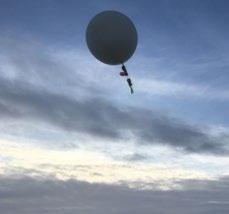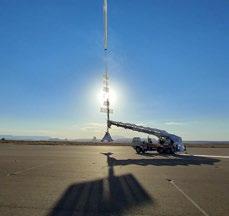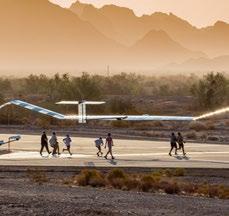
2 minute read
DE&S exploring capabilities in the stratosphere
from March 2023
by Desider


Advertisement
Ross
Project
I started as an artillery officer in the British Army, but now I’m part of DE&S’ Future Capabilities Group – our hub for strategic research and innovation. Our mission is to give our fighting forces and allies every opportunity to gain and maintain the operational advantage over our adversaries
Project Aether is one of DE&S’ most innovative areas of capability development. Its purpose is to explore how we can effectively operate in the stratosphere, the space 50 to 80,000 feet above the Earth, using high-altitude, long-endurance unmanned air systems. Successfully exploiting this space could mean huge potential benefits, but there’s still a lot left for us to learn about how to operate there, especially for long periods of time.

Aether’s scope encompasses the full end-to-end package, including the user in one spot, the effector in another, and the capabilities of the platform in between. The eventual platform will be used to conduct intelligence, surveillance, reconnaissance and rebroadcast activities over an ultra-wide area to support strategic and operational decision-making and shape tactical actions.
What makes Aether such an innovative project is both our exploration of the space above 50,000 feet and the openness with which we’ve approached the best way to operationalise it. Our working theory is that the turbulence we’ve all experienced in airplanes cruising at 40,000 feet doesn’t exist to the same degree in the stratosphere. If that’s right, we could send up really light aircraft for long periods of time, without worrying about them being battered by turbulent air. This could be a layer of the atmosphere with, we think, very little traffic or weather.
As the project’s evolved, we’ve taken care not to constrain the freedom of thought of our industry partners. We’ve remained platform agnostic throughout, leaving the door open to those that fly or float, whether held aloft by balloon or fixed wings and rotary blades. We’ve been deliberately vague on that front to allow the innovation to develop without precondition.
As we’ve learned more about the stratosphere, and how air densities and movement work at those altitudes, it’s reaffirmed our thinking that it was a good idea to keep things broad rather than to try and narrow it down. We’ve learned that balloon-based and fixed-wing systems have different positives and negative attributes.
We’ve come to see that it might be advantageous to have a range of available capabilities. For example, platforms that loiter in the stratosphere for longer periods of time and others that can support more deliberate operations, staying there for shorter fixed durations instead. A series of tools to support whatever activity is needed. We’re currently running test flights with prototypes from three industry partners – Sierra Nevada, Voltitude and Airbus.
I am absolutely convinced that Project Aether as a capability, and as a package, will give Defence that extra operational initiative to be more globally aware, more globally potent, more globally effective, both within the UK Armed Forces and alongside our NATO allies. I really think the future capability of these platforms could be an important element in winning the battles to come.








